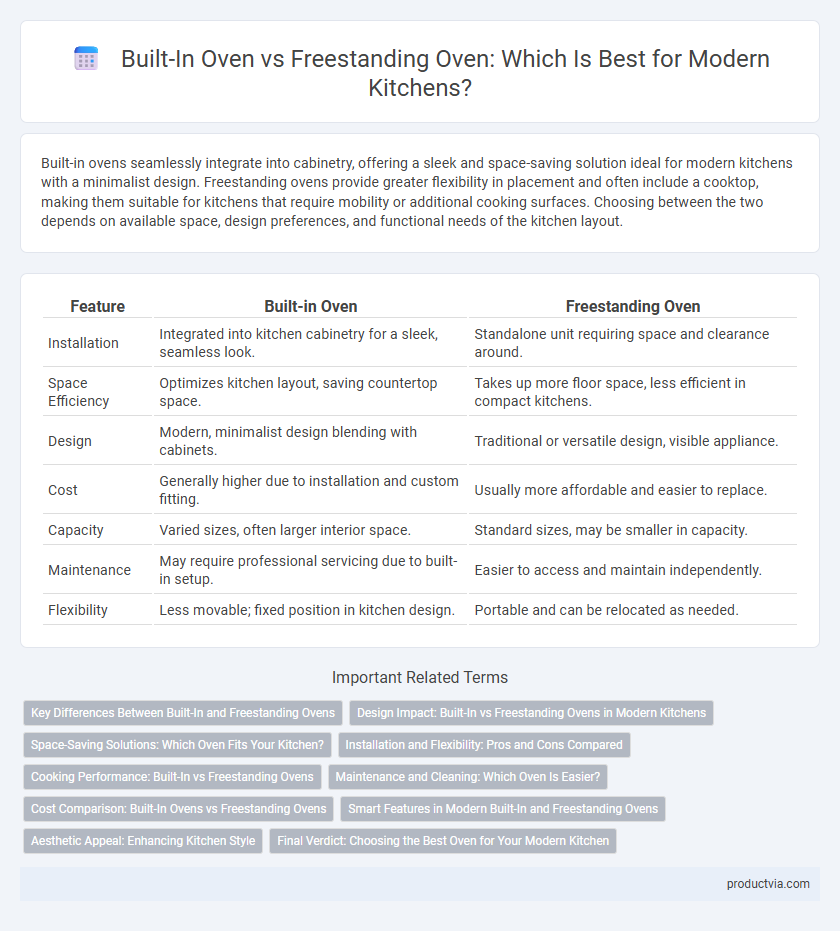Built-in ovens seamlessly integrate into cabinetry, offering a sleek and space-saving solution ideal for modern kitchens with a minimalist design. Freestanding ovens provide greater flexibility in placement and often include a cooktop, making them suitable for kitchens that require mobility or additional cooking surfaces. Choosing between the two depends on available space, design preferences, and functional needs of the kitchen layout.
Table of Comparison
| Feature | Built-in Oven | Freestanding Oven |
|---|---|---|
| Installation | Integrated into kitchen cabinetry for a sleek, seamless look. | Standalone unit requiring space and clearance around. |
| Space Efficiency | Optimizes kitchen layout, saving countertop space. | Takes up more floor space, less efficient in compact kitchens. |
| Design | Modern, minimalist design blending with cabinets. | Traditional or versatile design, visible appliance. |
| Cost | Generally higher due to installation and custom fitting. | Usually more affordable and easier to replace. |
| Capacity | Varied sizes, often larger interior space. | Standard sizes, may be smaller in capacity. |
| Maintenance | May require professional servicing due to built-in setup. | Easier to access and maintain independently. |
| Flexibility | Less movable; fixed position in kitchen design. | Portable and can be relocated as needed. |
Key Differences Between Built-In and Freestanding Ovens
Built-in ovens seamlessly integrate into cabinetry, offering a sleek, customizable look ideal for modern kitchen designs, whereas freestanding ovens include a cooktop and stand independently, providing flexibility in placement. Built-in models typically require professional installation and offer advanced features like touch controls and precise temperature settings, while freestanding ovens are often more affordable with easier installation and mobility. The choice depends on kitchen layout, space availability, and design preferences, balancing aesthetics against functionality and budget constraints.
Design Impact: Built-In vs Freestanding Ovens in Modern Kitchens
Built-in ovens offer a sleek, integrated look that seamlessly blends with cabinetry, optimizing kitchen aesthetics and saving counter space. Freestanding ovens provide flexibility in placement and can serve as focal points due to their standalone design, but may disrupt uniform kitchen lines. Choosing between built-in and freestanding ovens largely depends on prioritizing streamlined design integration versus installation versatility in contemporary kitchen layouts.
Space-Saving Solutions: Which Oven Fits Your Kitchen?
Built-in ovens offer seamless integration into cabinetry, maximizing counter space and creating a sleek, modern kitchen aesthetic ideal for compact areas. Freestanding ovens provide greater flexibility in placement with combined cooktop and oven units, often favored in larger kitchens where mobility and ease of installation are priorities. Choosing the right oven depends on kitchen layout, available space, and design preferences, with built-in models excelling in space-saving efficiency and freestanding ovens offering versatility.
Installation and Flexibility: Pros and Cons Compared
Built-in ovens offer a sleek, integrated look that maximizes countertop space and allows customization within cabinetry, but require professional installation and limited relocation options once fitted. Freestanding ovens provide greater installation flexibility, as they can be easily moved and installed without modifications to existing cabinetry, making them ideal for renters or those who frequently redesign their kitchen layout. While built-in models enhance modern kitchen aesthetics with flush finishes, freestanding ovens offer practicality and adaptability for varying kitchen sizes and styles.
Cooking Performance: Built-In vs Freestanding Ovens
Built-in ovens provide precise temperature control and even heat distribution, which enhances cooking performance and is ideal for baking and roasting. Freestanding ovens tend to offer more versatility with larger capacities and multiple cooking zones, accommodating diverse meal preparation. Both options deliver strong performance, but built-in ovens integrate seamlessly into kitchen cabinetry for a streamlined cooking experience.
Maintenance and Cleaning: Which Oven Is Easier?
Built-in ovens typically feature smooth surfaces and fewer exposed components, making them easier to wipe down and maintain in modern kitchens. Freestanding ovens often have gaps between the appliance and cabinetry that can accumulate dirt and grease, increasing cleaning effort. Self-cleaning functions are more commonly integrated into built-in models, further reducing maintenance time.
Cost Comparison: Built-In Ovens vs Freestanding Ovens
Built-in ovens typically have a higher upfront cost due to custom cabinetry integration and professional installation expenses, averaging between $1,000 and $3,000. Freestanding ovens offer a more budget-friendly option, with prices ranging from $500 to $1,500, and they require minimal installation effort, reducing labor costs. When considering long-term value, built-in ovens enhance kitchen aesthetics and resale value, while freestanding models prioritize flexibility and lower initial investment.
Smart Features in Modern Built-In and Freestanding Ovens
Modern built-in ovens often feature advanced smart technology, including Wi-Fi connectivity, voice control compatibility, and app-based cooking programs that enhance precision and convenience in contemporary kitchens. Freestanding ovens also incorporate smart features such as touch-screen controls and remote monitoring but tend to offer greater flexibility in placement compared to built-in models. The integration of sensors for automatic cooking adjustments and integration with smart home systems is increasingly common in both types, catering to tech-savvy users seeking efficiency and customization.
Aesthetic Appeal: Enhancing Kitchen Style
Built-in ovens offer a sleek, integrated look that seamlessly blends with cabinetry, enhancing the minimalist and modern aesthetic of contemporary kitchens. Freestanding ovens provide versatility and easier installation but may disrupt the uniformity of kitchen design due to their standalone presence. Choosing built-in ovens elevates kitchen style by creating a streamlined, cohesive visual appeal favored in modern interior design.
Final Verdict: Choosing the Best Oven for Your Modern Kitchen
Built-in ovens offer a sleek, integrated look that maximizes space and complements modern kitchen designs with seamless cabinetry alignment. Freestanding ovens provide flexibility in placement and often include combined cooktop options, making them ideal for versatile kitchen layouts. Selecting the best oven depends on your kitchen's design priorities, space availability, and preference for customization versus mobility.
Built-in oven vs Freestanding oven for modern kitchens Infographic

 productvia.com
productvia.com